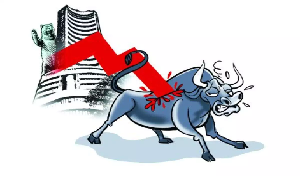Benchmark equity gauges – Sensex and Nifty – hit over three-month lows on Friday due to emergence of massive sell-offs in bank stocks.
The Sensex closed 874 points or 1.45 percent lower at 59,331. Intraday, the BSE benchmark fell over 1,200 points. Likewise, the NSE Nifty plunged 288 points or 1.61 percent to settle at 17,604. These are the levels not seen by both Sensex and Nifty in over three months.
Here are five major factors which led to the market mayhem today:
. Massive selling in Adani group shares
Shares of all seven listed companies of the Adani conglomerate – controlled by Asia’s richest person Gautam Adani – saw a continued selloff for a second straight day on Friday.
Shares of the group companies plunged about 20 percent on Friday, reacting to a report by Hindenburg Research, a US short seller. The report triggered a rout even on Monday.
Seven listed companies of the Adani conglomerate have lost a combined $48 billion in market capitalisation since Wednesday.
2. Pre-Budget nervousness:
Analysts are of the view that pre-budget jitters too have added to the market volatility as the stock market usually trades lower ahead of the Union Budget Day.
Market participants are hoping FM Nirmala Sitharaman will announce some key measures including infrastructure spending and steps to attract more funds from the private sector. Experts, however, cautioned that If street expectations are not met, market could fall further.
3. Selloffs in banking stocks
Banks like SBI, ICICI Bank, Axis Bank, HDFC Bank and kotak Bank emerged as major laggards, diving as much as 4.7 percent.
These banks have fallen amid concerns over their exposure to the Adani Group.
“The sharp slump in the Indian market was triggered by an unfavourable research report on Asia’s richest promoter group companies. This is also affecting the banking stocks even though the results of the sector are optimistic due to high group lending, indicating potential risk. PSU banks are the most impacted compared to private banks owing to high exposure. The FIIs’ cautious stance ahead of the Union Budget and FOMC meetings also fuelled the collapse,” said Vinod Nair, Head of Research at Geojit Financial Services.
4. Economic growth concerns:
The United Nations has cut its GDP growth forecast for India for the calendar year 2023 to 5.8 percent, citing the effect of tighter monetary policy and weak global demand.
4. FII outflows continue
Market sentiments are dampened by persistent FII selling, where funds are being shifted to other emerging markets as a result of attractive valuations, analysts said.
Till date, foreign institutional investors have already around $1.61 billion in stocks. Financials and IT have faced the brunt of this selling, followed by consumer services, oil & gas, telecommunication and autos.
5. US Fed rate hike worries
The US economy grew at a 2.9 percent annual pace from October through December, which was better than expected. Forecasts were of a 2.3 percent growth. This indicates that the US Federal Reserve might remain hawkish for a longer period of time.



